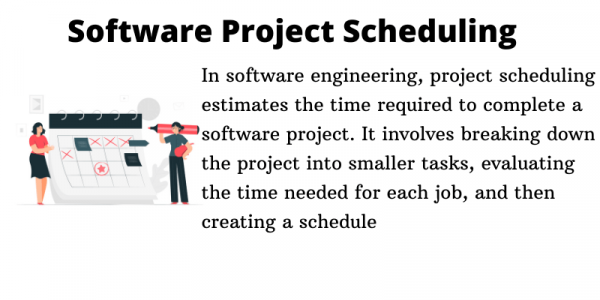You must be prepared to handle projects in different industries as a project manager. Somehow you may find yourself leading software development or engineering team.
Project scheduling is a critical part of the software engineering process in this scenario. By creating and adhering to a schedule, you can ensure that your project stays on track and meets all deadlines.
In this article, we will discuss the importance of project scheduling in software engineering and offer tips for creating an effective schedule.
What is Project Scheduling in Software Engineering?
In software engineering, project scheduling estimates the time required to complete a software project. This process involves breaking down the project into smaller tasks, evaluating the time needed for each job, and then creating a schedule that outlines when each task will finish.
Project scheduling is an integral part of project management, as it helps to ensure that the project is completed on time and within budget. By outlining the tasks, you need to finish and when they need to be completed, project scheduling helps ensure that software projects are delivered on time and within budget.

Why Is Project Scheduling Important?
There are several reasons why project scheduling is so important in software engineering.
- It allows you to estimate the time required to complete a project accurately. It is essential to ensure that the project stays on track and does not go over budget.
- It helps you allocate resources efficiently. It includes human resources (such as developers and testers) and material resources (like hardware and software). You can avoid costly delays and rework by ensuring that the right resources are allocated to the right tasks.
- It provides visibility into the progress of a project. This visibility is essential for identifying potential risks and issues early on so they can be mitigated or avoided altogether.
Different Methods for Project Scheduling
You can use various methods for project scheduling, including Gantt charts, the Critical Path Method (CPM), and Program Evaluation Review Technique (PERT). While each method has benefits and drawbacks, the most critical aspect of project scheduling is providing a clear roadmap for the project team to follow.

How to Create a Project Schedule in Software Engineering
Identify tasks you need to accomplish
Before creating a project schedule, you need to identify all the tasks you should accomplish to complete the project.
It may seem like a challenging task, but there are a few ways to make it simpler. First, take a close look at the project goals and objectives. It will give you a good idea of what you need to do to achieve the desired outcome.
Next, break the project down into smaller manageable parts. Once you have a list of all the tasks you need to finish, you can start creating your project schedule. Common examples in software engineering in this phase could be developing use cases, creating class diagrams, writing code, etc.
Estimate the duration of each task
Next, you will need to estimate the time required to complete each task. You can do this using a bottom-up estimation technique, which involves breaking each task into smaller subtasks and assessing the time required for each subtask.
Once you have estimated the time needed for each task, you can create a project timeline by assigning start and end dates to each task.
Allocate resources
One of the most critical steps in creating a project schedule is allocating resources. It includes identifying the human, financial, and material resources necessary to complete the project.
Once you have identified these resources, it is essential to determine how to use them. For example, if a project requires many materials, it may be necessary to purchase them in advance. Similarly, hiring additional staff or bringing in outside contractors may be needed if a project requires a great deal of labor.
By carefully allocating resources, it is possible to create a project schedule that meets the project’s needs while staying within budget.

Benefits of Project Scheduling
Any successful project manager knows that effective project scheduling is essential to the success of any project. There are many benefits to creating and maintaining a schedule, including prioritization, tracking, resource management, risk management, and stakeholder satisfaction.
- Prioritization – By prioritizing work through scheduling, project managers can ensure that the most critical tasks are completed first. It is crucial when there is a limited amount of time or resources.
- Tracking – Progress through a schedule also allows project managers to identify issues early on and make necessary adjustments.
- Resource management – Understanding what tasks need to be completed and when project managers can allocate resources more effectively. It includes physical resources like materials and equipment and human resources like labor.
- Risk management – By mapping out a plan and identifying potential risks, project managers can take steps to mitigate them before they cause serious problems.
- Stakeholder happiness – By keeping stakeholders informed of progress and ensuring that their needs are being met, project managers can build trust and keep everyone happy.
As you can see, there are many good reasons to create and maintain a schedule for your next project. With so many benefits, it’s hard to imagine why any project manager would choose not to use this valuable tool.

Tips for Successfully Completing a Project on Time
After creating a project schedule, there are two things that you can do to make sure you complete a project on time:
Track progress regularly
Keep track of your progress on each task regularly. It will help you identify potential risks or issues early on to address them before they cause significant delays.
Communicate openly
Make sure that everyone involved in the project understands their roles and responsibilities. Additionally, keep all stakeholders updated on the project’s status regularly so they can provide input or raise concerns on time.
Following these tips can increase your chances of successfully completing your next software engineering project on time.
Project scheduling is integral to software engineering because it allows accurate completion time estimation while avoiding going over budget. Creating a well-executed schedule requires identifying all tasks, estimating durations, allocating adequate resources, tracking progress regularly, and communicating openly with everyone involved to ensure successful completion
